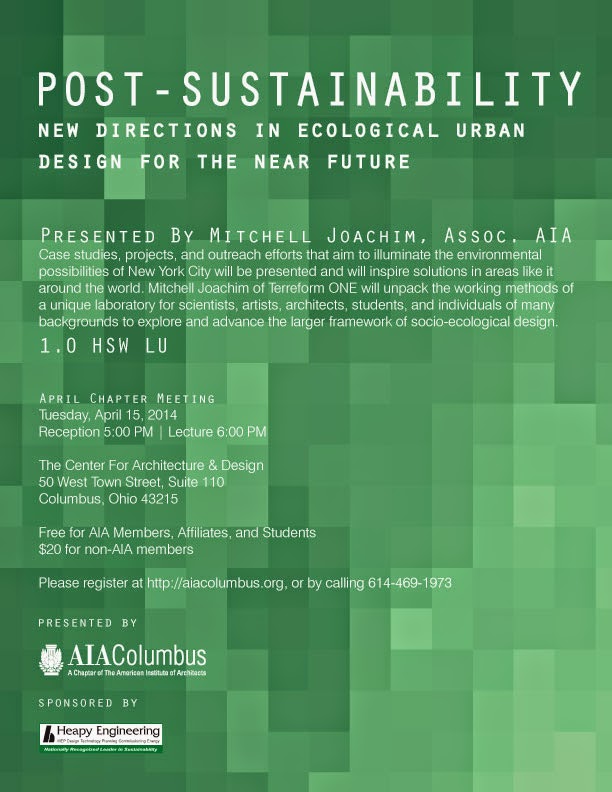Who Creates the City? Stagnation in climate policy, vacant properties in the post-industrial
city, privatization of public spaces and displacement of socially
vulnerable people from the city. Increasing numbers of citizens no
longer intend to wait and are taking their future into their own hands.
They are repurposing abandoned buildings, trying out resource-saving
ways of life and they are demanding their right to the city. How is the
self-organization and horizontal linkage between these civil-society
actors succeeding?
Davis Kanepe, Cultural Activist, Kanepes Cultural Center, Riga
Mitchell Joachim, Architect and Professor, New York University
Purev-Erdene Ershuu, Architect and Lecturer, Mongolian University of Science and Technology
4.24.2014
4.11.2014
AIA Columbus, Lecture with Mitchell Joachim
The American Institute of Architects lecture on Post-Sustainability; New Directions in Ecological Urban Design for the Near Future, Mitchell Joachim, The Center for Architecture and Design.
http://www.aiacolumbus.org/index.php/programs-events/chapter-meetings/226-april-chapter-meeting-post-sustainability-new-directions-in-ecological-urban-design-for-the-near-future
http://www.aiacolumbus.org/index.php/programs-events/chapter-meetings/226-april-chapter-meeting-post-sustainability-new-directions-in-ecological-urban-design-for-the-near-future
4.07.2014
4.02.2014
BBC News, What if we could rebuild New York City? by Mitchell Joachim of Terreform ONE
The new New York City would balance the relationship between the information networks that the metropolis depends on and Earth’s finite resources.
All vital components of life would be monitored and attuned to the needs of every organism, not just humans. Supplies of food and water, our energy and waste and even our air would be sensibly scrutinized. Thanks to masses of miniaturized low-cost electronic components deployed across the city, communication becomes far easier. New York will grow and adapt to millions of new minds entering it everyday.
The city would make sure every need is provided for within its borders. How we provide nutrients, transports, and shelter would be updated. Dilapidated buildings would be replaced with vertical agriculture and new kinds of housing would join cleaner, greener ways to get around the city. What were once streets become snaking arteries of livable spaces, embedded with renewable energy sources, low-tech, green vehicles for mobility and productive nutrient zones. The former street grid could provide the foundation for new flexible networks. By reengineering the obsolete streets, we can create robust and ecologically active pathways.
While all this may sound optimistic, some of this city of tomorrow is already taking shape... see:
http://www.bbc.com/future/story/20140402-a-vision-of-new-york-in-2050
4.01.2014
A+ Award Popular Choice Winner, Terreform ONE
Terreform ONE, BIO CITY WORLD MAP OF 11 BILLION is the A+ Award Popular Choice Winner in the Plus Category | Architecture + Communication.
This
is an unparalleled honor. With entries from over 100 countries, this
work truly represents the best of architecture worldwide. The Architizer
A+ Popular Choice Winner is selected by the online voting public after a
three week long campaign.
Subscribe to:
Comments (Atom)








